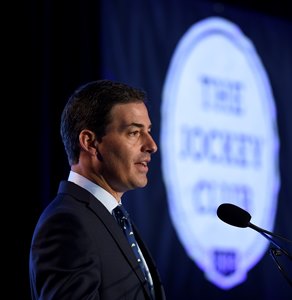Gagliano Calls for Improved Out-of-Competition Testing


By James L. Gagliano
It has been called “racing’s latest medication scandal” and that is probably an understatement when one fully considers the consequences to participants who abided by rules and to bettors who assumed that all horses were competing on a level playing field.
On Monday, Dec. 19, 2016, the California Horse Racing Board announced that it had filed a complaint asking the Santa Anita Park stewards to disqualify Masochistic from his second-place finish in the TwinSpires Breeders’ Cup Sprint (gr. I) and redistribute his share of the purse ($255,000) based on positive test findings for the anabolic steroid stanozolol.
Masochistic, trained by Ron Ellis, finished second in the sixth race at Santa Anita Park (the Breeders’ Cup Sprint) Nov. 5, 2016. Post-race blood and urine samples taken from the horse were analyzed by the Maddy Laboratory at U.C. Davis and found to contain the Class 3 drug stanozolol and its metabolite 16-hydroxy stanozolol. A hearing on the matter is scheduled on Dec. 30, 2016.
Regardless of the outcome of the proceedings, it seems clear that the celebration and self-congratulation by the racing industry when numerous jurisdictions banned steroids in the wake of public admissions by the trainer of Big Brown in 2008 that the colt was regularly treated with steroids were indeed premature.
This case illustrates that, even in our major championships, trainers and veterinarians have conveniently found a means to avoid the goal the industry promised it would meet several years ago: the elimination of the use of steroids in and around competition.
As we have noted in the past, the industry’s general lack of acceptance of out-of-competition testing has been troubling, as well.
Virtually every other sport, and virtually all major racing jurisdictions around the world, use vigorous out-of-competition testing to ensure integrity. Athletic governing bodies now fully recognize that the muscle development and weight gain effects of steroids extend well beyond the period of administration and the limits of detection through blood or urine tests.
According to the Racing Medication and Testing Consortium website, only 19 of 38 U.S. jurisdictions that have pari-mutuel horse racing have even published regulatory guidelines for out-of-competition testing. Among those states, wide variation exists in the breadth and depth of out-of-competition testing rules and protocols.
In 2013, The Jockey Club announced the creation of a Graded Stakes Out-of-Competition Testing Grant Fund program to encourage more out-of-competition testing for the presence of blood-doping agents and Association of Racing Commissioners International Class 1 substances.
Racetracks in California, Florida, Kentucky, New York, West Virginia, and the province of Ontario (Woodbine) have taken part in the program.
The Jockey Club’s board of stewards has once again earmarked funds for out-of-competition testing in 2017. We can only hope that, in light of this high-profile case, more parties will seek our funding.
The Jockey Club is today calling for all regulators in North America to take emergency measures to immediately adopt RMTC’s new model rule for out-of-competition testing that was recently passed by the RCI. That rule mandates that horses treated with any anabolic steroid spend at least six months on a vet’s list, therefore making them ineligible to race.
In addition, The Jockey Club, through the Coalition for Horse Racing Integrity, will continue to advocate for federal legislation to unify horse racing medication regulation and elevate our sport to the highest standards.
This issue is much more than racing’s latest medication scandal.
The real scandal would be if we, as an industry, fail again to take prompt, necessary, and comprehensive action.
